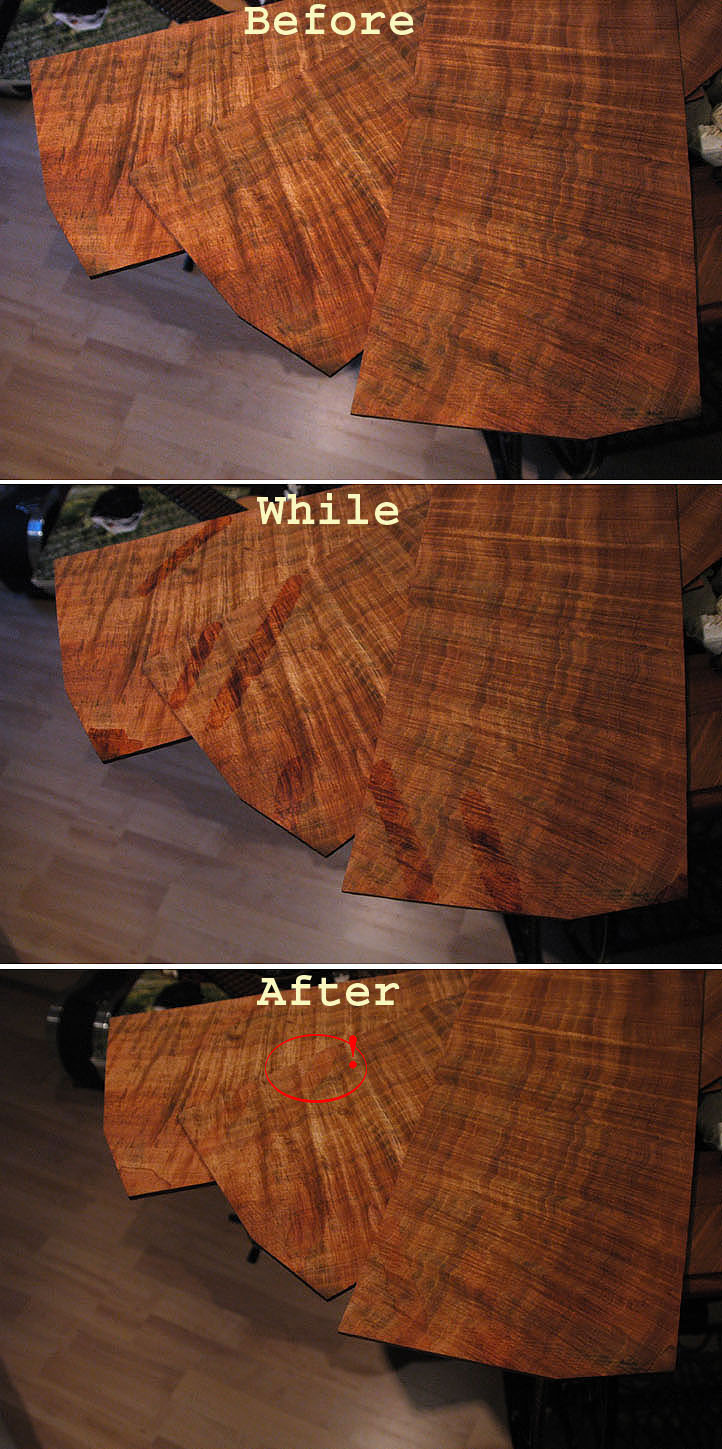trevtheshed wrote:
Blackwood goes "black" due to tannins, iron and an alkali environment. There is usually enough tannin and iron around in the native wood for an alkali environment to turn the wood "black" (where "black" also means the dirty green, brown etc. that blackwood and your hands will turn).
That is the simple truth of it right there. The green/black discolouration has very little to do with slats, paper, or anything else. The two culprits, mineral deposits + alkaloid tannins are already 'in' the wood itself to varying degrees.
After wetting, those elements if present, will go into solution. When heat is then applied the solution is bought to the surface where oxidation occurs almost instantly causing the colour change. The more water applied, the more minerals and tannins will be dissolved and therefore the more pronounced the problem is likely to be.
Tannin leeching was a problem noted by the timber flooring industry with the introduction of water-based finishes and it is not restricted only to blackwood. As I recall from my reading a few years back, blackbutt and spotted gum are very prone as are a good number of the lighter colour European species commonly used for flooring in and around Germany.
The fact that this was a problem in Europe was actually a very good thing for the floor finishing industry in AU. It meant that all the research to resolve the problem was done for them. I think it was the German company 'Bona' who came up with a clear polyurethane (there's that word again) primer which effectively isolates these soluble elements within wood from contact with water contained in epoxy finishes while retaining excellent adhesion between substrate and the finish film.
Doing that solved the problem well enough to allow these wondrously tough abrasion resistant single and two pack water based epoxy floor finishes on 'any' type of wood without staining, even blackbutt....So how does this help you?? Well it doesn't just say'in tis all.

Mind you it does verify that, unfortunately, water and blackwood 'do' mix, but in an ugly way...so we do need to be careful. Distilled water won't make any difference because we now know the problem is 'any' water....So I wonder how things would go if you were to pre-coat the sides with Bona Prime Intense prior to bending?? Everything indicates that if you use as little water as possible when bending blackwood, you will minimise the undesirable affect. Then if you do strike a problem, at least it will not be so bad and should allow a milder solution of oxalic acid to be applied to rectify.
But to take things a step further I note that Nick had mentioned in his acetone/rosewood experiment how he had been surprised by the amount of water extracted in that process from what he thought had been quite dry wood. Also Bob Taylor's factory bending process does not incorporate water at all, he explains that his process "relies on the moisture trapped in the wood even when it is fully dry".
When you think about it, even wood with a reading as low as 8% moisture, the joinery standard for good stability, still holds quite a bit of water...errrm about 8% to be precise. So even at that point, every KG of wood is retaining 8 grams of water..That may not sound like very much but it will produce quite a lot of steam...The point is that even if you use 'no' water when bending blackwood, there remains every potential, all be it to a lesser degree, for mineral/tannin staining to still occur as these elements are taken into solution by this "trapped" moisture being released to the surface by heat.
If this Bona Intense primer/sealer can withstand the heat and maintain its good adhesion properties and continue to do its job of preventing contact between the mineral/tannins and oxygen in the atmosphere, it would presumably eliminate the problem entirely...it may also go a good way toward filling the grain too...just thinking out loud.

If anyone is interested I have attached a link to this Bona product. Of course Bona is probably not be the only company making this kind of stuff but the link should support the fact that tannin leeching is nothing new and is not restricted to only those of us who bend wood.
http://www.bona.net.au/Architects/Produ ... t=Coatings
Cheers
Kim
